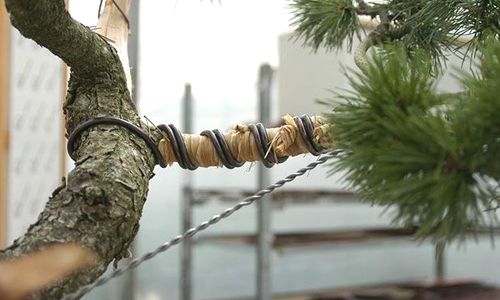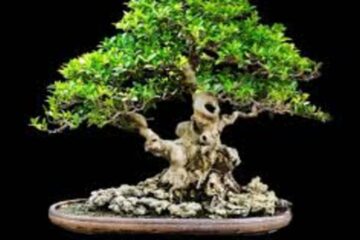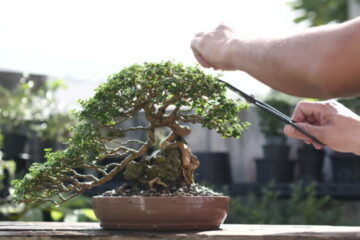If you have a kind of bonsai, you will surely be wondering about how to wire a bonsai tree and what are its benefits. The first thing we want to tell you is that wiring a bonsai is one of the procedures required to keep a specimen healthy and strong.
Now, if you are asking yourself the question, how to wire a bonsai tree , I want you to know that here we will give you all the tools to achieve it.
Wiring is a technique used to style and shape miniature trees. It consists of wrapping metallic cable around the branches of the specimen with the purpose of putting the branches where they should go.
If the tree’s branches are significantly thicker than any other species, the person in charge will determine the type of wire to use . The gauge of the wire depends on the thickness of the branches.
The process of getting the branches back into their proper shape will take a few weeks or months. The fundamental thing about this is that when the wire is removed, these branches can be kept in that position.
This technique is challenging and a challenge for people in charge of a bonsai, but it is part of the modeling process . If we can determine anything, it is that all bonsai of a significant age that have an aesthetic form have at some point been wired.
The envelope helps to promote the creation of thick trunks with a resistant bark and the branches will obtain a more realistic style. Branches that have just finished forming can be wired horizontally or from top to bottom to give the appearance of longevity.
Why do you have to wire the bonsai?
Content Overview
Credit :expertoenbonsai.com
The specimen must be wired for different reasons and these are: greeting and design. In terms of health, it is important to wire the bonsai because a better arrangement of the branches must be sought and the specimen must obtain light.
Another reason why it should be wired in terms of health is that the specimen can obtain air, especially in weak areas and at low heights. The air allows the different regions of the miniature tree to be kept cool and for this reason they will not dry out.
The force of the tree will be effectively distributed with the wire, with its weak areas increasing support and strong areas decreasing it.
Regarding design, which is the second reason of importance, it is essential to say that the wiring improves the appearance of the specimen . This is sought in order to put the branches in the place where the user wants and where they can be put.
The fence also guides the user so as not to cut those branches that are essential and must be maintained. Let us remember that when cutting branches the bonsai suffers and if these are important for the specimen, the bonsai will suffer.
Now we do wire the bonsai and it is not in an optimal state of health. It has weak shoots , growth is poor, it is diseased, or it was transplanted very recently. It is important that wiring is not done.
Let us remember that the fence is a technique that reinforces pruning and settlements, only that the fence seeks that the branches do not cross. Wiring gives us an advantage over pruning and that is that we keep the tree healthier and more vigorous.
When should a bonsai be wired?
Since we know a little more about how to wire a bonsai, it is important to define the best time of year for it. The moment should be sought when the tree is not in its growth period, so spring is not a good option. Winter and autumn are the most recommended times of the year for wiring. Since the tree is not growing, the bark does not widen as much and the wire does not damage the surface.
Types of specimens such as conifers can be wired during any month of the year, although it must be monitored that the wire is not penetrating the bark. Deciduous trees should be wired when they are leafless , which is in late fall.
Wiring depends on a fundamental factor known as torque. High twisting of the wire should be carried out during the winter sleep of the specimen. New shoots are not advised to wire because the branches grow fast enough and then the wire leaves unsightly scars.
It is important that the bonsai caretaker is watching how the specimen is doing with the wire and remove it at the right time.
Evergreen miniature trees should be wired in the fall and winter. This is because during these months the circulation of the sap in the bark of the trunk is minimal. Not all species can be wired and the bonsai must be of a suitable age to be subjected to this process.
What do I need to wire a bonsai?
To wire a bonsai I need a series of recommended materials to be able to do the process properly. Various types of wires can be used for this, which are anodized aluminum wire and annealed copper wire.
Aluminum wire is recommended for novice bonsai keepers because it is easier to handle . This type of wire is available in any store, especially those of bonsai and botany.
The wire of any material has different thicknesses which can vary from 1 mm to 8 mm. The person in charge of wiring can choose between different types of gauges available, either 1 mm, 1.5 mm, 2.5 mm, 4 mm. These last mentioned are the most recommended for the process.
When winding the wire on the specimen, it is crucial to wire the thick branches with a greater twist than with the small branches. For this, the use of raffia is recommended to give protection to the branches, preventing them from being damaged.
The raffia sometimes produces wounds or scars on the body of the bonsai, wounds that can exceed those caused by the bonsai. For this reason, it is essential that the use of this element be cautious.
To cut the wire from the roll and what is left over when holding the bonsai trunk, you need the use of special scissors to cut wire. There are several models for that that can cut 106 mm and 208 mm as well as wire cutters and clippers
These utensils can be found in specialized bonsai stores and the store manager will give you the best possible recommendation so that you do not make a mistake when choosing a scissors or clippers model.
Read More : Bonsai Clippers Vs Bonsai Scissors -Which Is Best For Trimming Your Bonsai Tree and Why?
Copper wire VS aluminum wire, which is better?
There are two types of wires on the market which depend on their manufacturing material as mentioned above, aluminum and copper. Aluminum wire is characterized by being malleable and does not reduce its flexibility compared to other elements. These are the reasons why aluminum wire is more used for this practice.
Aluminum wire can be found in the market in silver and black colors. However, this will not change its performance at all.
Now, the copper wire is the one that is used especially for bonsai of the coniferous type. It is used for these species because they maintain stronger growth and shoots appear in less time than in other species.
Conifers have the characteristic that when they grow they exert greater pressure on the wire and copper is chosen over aluminum, because it resists that pressure. Copper, despite being a malleable metal, when exposed to the sun and water , becomes hard and loses flexibility.
The copper wire has the ability to keep the branches of the conifer in place and that the species does not lose its shape. Copper, having a reddish color and when it oxidizes a more brownish tone, camouflages itself perfectly with the surface of the trunk, going unnoticed.
So in this comparison we are going to choose copper wire only in the case of wiring coniferous bonsai. We will use the aluminum wire for the other types of species, especially when we are beginners.
How To Wire a Bonsai Tree?
A way should be found to join two nearby branches of similar thickness to wire with the same section of wire. The rest of the branches will be wired separately if they are separated, this is known as simple wiring.
Before bending the branches and shaping them, it is better to wire them, trying to start the work with the primary branches and then with the secondary ones . The wire must have an adequate thickness so that it can hold the branches in the position we want.
Wiring a bonsai step by step

- Find the branch you want to wire.
- Finding the right thickness of the wire, this can be complicated, so we advise you to follow the appropriate recommendations that we explain.
- Wind the wire at 45 degrees on the branch.
- With special scissors or wire cutters, cut what is left over from the wire section.
- Where there is a side branch we wire a thin section and then increase the thickness.
- At the end of the branch we will use a thinner section.
- After having wired all the branches they are bent in the desired position.
- If we need to lower a branch because it is too high, we can use a turnbuckle or hook to remove elevation. This hook can be used together with a rubber protection.
- A piece of fine wire is added to the hook and attached to the pot or root, looking for a way to make tension.
- The wire should be removed just before it begins to leave marks caused by the increased thickness of the bark.
Wiring according to bonsai species
The species will require a different wiring depending on the type of each one of them. Coniferous species can be wired at any time of the year. But it is recommended from spring to autumn. These species can recover after fencing in the winter months . For this reason they can be wired in the fall.
Conifers require wire on their branches for longer and if they still have wire in winter, we need to protect them from low temperatures and frost. This type of specimen requires an annual wiring and if it is possible that the wire is distributed throughout the body of the bonsai.
In the case of looking for heavy curves , the wiring should be carried out at the end of summer until the beginning of autumn. Wiring when done in late summer heals faster due to new growth.
Pine trees need fencing especially at the end of summer, because the branches thicken. After these months, the wire can last longer and heal better.
Coniferous species should be strictly wired in spring and in summer constantly check the bonsai for scars. Pines, unlike conifers , swell for the summer months.
As for tropical species, these should be wired in any month of the year because they are not exposed to frost and do not go through periods of inactivity.
Wire used for tropical species can be cut quickly because they maintain rapid and vigorous growth . This is reason to review these species constantly avoiding injuries.
Double wiring of a bonsai

It is a technique where you first have to clean the branches that are no longer useful. This will improve the final technique and make the process easier. Then branches must be selected in pairs looking for them to be of the same caliber . Before passing over a branch, it is necessary to wrap the wire around the trunk one or two times, preventing another branch from moving when modeling a branch.
The wire must be cut with the necessary length to wire a couple of branches, then the wire is wrapped around the trunk and then other wraps are given to hold the branch at one end, so that the second branch can be fixed from the base. base of the trunk to the tip.
The wire must form a 45 degree angle with the branch to provide the necessary tension it requires. Gradually the branch will get fatter in the growth stage.
This process should now be repeated at the other end of the bonsai looking for the branches that are arranged in pairs. Individual branches must then be wired to complete the process.
When there is a branch that comes out from the trunk, it must be wired from below and when you want to wire a branch upwards, it must be wound starting from above.
Single branch wiring
Credit : expertoenbonsai.com
For this modeling technique, the wire must be cut to the length needed and the trunk must be turned at an angle of 45 degrees . When different wires are used, they must be wound looking for the same direction of rotation and joining them to each other.
The branch must be wired up to the top of the bonsai and as the extension of the branch is completed, it is even necessary to reduce the gauge of the wire because the thickness of the branch decreases.
Tips for wiring a bonsai correctly
One of the tips they offer you is to use a type of wire that maintains an adequate thickness. For this they recommend that the wire has 30% of the thickness of a branch. For example, if the branch is 2 cm thick, the wire I am going to use should be 66 mm thick.
This is not something clearly mandatory , since all woods do not have the same hardness and flexibility. The technique that we are going to recommend is to take the wire that we are going to use and put pressure on a branch to bend it. When doing this we can observe two possible results.
The first result is that, if when applying pressure with the wire, the branch remains completely static and the wire bends, then this is very fine and we must look for one of a larger caliber.
The second possible result is that if, when pressing the wire against the branch, if the fame moves, but the wire does not, you are with the correct gauge. This way you will be able to identify the gauge of wire you require.
After making the wiring and we have obtained the appropriate modeling, it is essential to place the bonsai in the shade for a period of time. Then it must be fertilized regularly and you must monitor it constantly , preventing the wire from burying itself in the trunk.
The most appropriate thing, once the wire has fulfilled its function, is to remove it by cutting it at the points where it was twisted. Re-wiring aluminum or copper can damage the bark of the trunk and we recommend that you do not.
When should a bonsai tree be wired?
Wiring a bonsai can be done at any time of the year, however, in winter they will need more care than at other times. This is because temperatures can drop very low. If a bonsai wired in winter has recent marks, the fracture may not heal due to exposure to cold. This leads to the death of the branch that has the scar.
The best time or season to wire a deciduous tree is after the leaves fall in the fall. Since the branches are bare, the wiring process becomes easier and the branches can be adjusted better.
Any cracks or intensity curves that a bonsai has must heal completely before winter arrives . Deciduous trees can even be wired in spring, but care must be taken with new daughters because they can break off.
When the species are fast growing, it should be checked that the wire is not nailing the bark of the trunk and branches . The deciduous trees during the middle of the summer can also wire because the defoliation process has been previously carried out. The leaves have not taken their new positions and the process is easier.
When to unwire a bonsai?
A fenced tree does not stop growing and the branches and bark of the tree increase in thickness. The wire will always tighten the bonsai, but it must be avoided that it leaves marks. A light marking of the wire can be reduced over time, however, we must avoid generating a deep marking.
The wire must be removed before deep marking is caused, because these scars can even last permanently . The ideal way to remove the wire is to cut at each point where it has made a turn.
Unwinding by uncoiling can cause leaves and branches to break so this practice is not recommended. We do not recommend that wire that has already been used be recycled as this affects the species. Also, the copper cannot be recovered when the wire section already has kinks.
Read More :
FAQ
Can you bonsai without wire?
Yes, it is possible to make bonsai without wiring. You can apply manual pruning and transplanting techniques to grow bonsai naturally.
Can you use copper wire for bonsai?
Yes, you can use copper wire for bonsai. But it’s stronger than aluminum wire, so you don’t have the ability to re-bend if necessary.
Can you use steel wire for bonsai?
Steel wire is only applicable for bypassing extreme bends. For thinner branches, it is not an ideal option.
Can any bonsai wire be used?
No, you cannot use any kind of wire for Bonsai wiring. The best and most effective way is to use aluminum and annealed copper or steel wire.
What size of bonsai wire to use?
Bonsai wire comes in different thicknesses from 1 to 6mm. There is no standard size for selecting a wire gauge. The size of the thickness depends on the thickness of the branch. Try to keep a thickness wire thinner than your branch.
When is the right time to wire?
There is no specific rule to start wiring. You can apply the wiring during the age tree from three to five years. It is not advisable to start wiring before root development. You can do wiring on an adult bonsai.
Final Thought
Now you know how to wire a bonsai tree. We try to cover all the tips and tricks to make your wiring effective and hassle-free. Follow this guide to give your bonsai an aesthetic look and growth.
When you are wiring a bonsai, be careful about the length. You should not maintain the wiring for a long period of time to avoid damage to the plant. In addition to balancing the bonsai shape, we also talk about how to grow your bonsai quickly. You can apply to re-pot for better growth.





